Mosquito-Borne Disease: Environmental Justice, Geopolitics, and Biotechnology.
How can we defeat this antagonist of the Anthropocene?
This post covers the historic and future importance of mosquito-borne disease (MBD), overviews the approaches to MBD mitigation, and makes recommendations. (Approx. 2000 words).
History’s Deadliest Animal, By a Lot
Mosquitoes have been around for over 100 million years and cover the Earth with over 3,500 species—there may be 10 million times more mosquitoes than humans. Some of these mosquitoes may have evolved to specially target humans, and some of them carry deadly and brutal diseases including malaria, yellow fever, and dengue. Mosquito-borne disease (MBD) still kills as many as 1,000,000 people a year — more deadly than all other animals combined. Malaria alone kills nearly 750,000 human per year making it the 14th leading cause of death (2019).
Perhaps no animal has steered the course of human history as dramatically as the mosquito. According to Prof. Tim Winegard, the “mosquito has determined the fates of empires and nations, razed and crippled economies, and decided the outcome of pivotal wars, killing nearly half of humanity along the way.”
Mosquito-borne disease (then called miasma and/or malaria, both translating to “bad air) often played a key role in repelling foreign invaders: the Mongols from Southern Europe, European Crusaders from the Holy Land, Carthage from Rome, Scottish colonists from South America, and the Ming Dynasty from Southern Asia, as well as possibly killing 90% of indigenous people in the Americas. We might consider mosquitoes a keystone species—and a central antagonist—of the Anthropocene, the era of human domination of Earth.
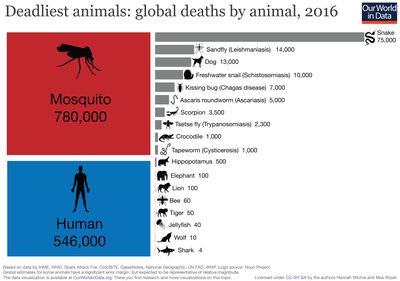
Mosquitoes May Be A Major Environmental Justice Issue
Most mosquitoes require standing water, warm temperatures, and blood meals from animals to reproduce; thriving in marshy, tropical, and urban environments. Wealthy nations have curbed or eradicated mosquito-borne disease by draining wetlands, spraying insecticides, and controlling bite exposure, particularly beginning in the early 20th century (but with some efforts going as far back as ancient Rome).
In much of Africa, South America, and Southeast Asia, mosquitoes remain a rampant killer rather than a mere nuisance. It has been hard to find data on whether those regions have suffered from relatively higher mosquito populations even before the Industrial Revolution (~1750s onward), but I assume so given the environmental conditions and reports of European colonists struggling with mosquitoes.
This leads me to wonder whether
mosquito-borne diseases may have delayed urbanization in the Global South and therefore made those societies more susceptible to the horrors and setbacks of colonization,
whether those diseases might still be seriously holding back the Global South, and,
whether MBDs may yet further exacerbate geopolitical inequality as mosquito populations expand into new ecological niches opened up by climate change and habitat destruction, disproportionately harming places less resourced to handle increased mosquitoes (historically, because of #1 and #2).
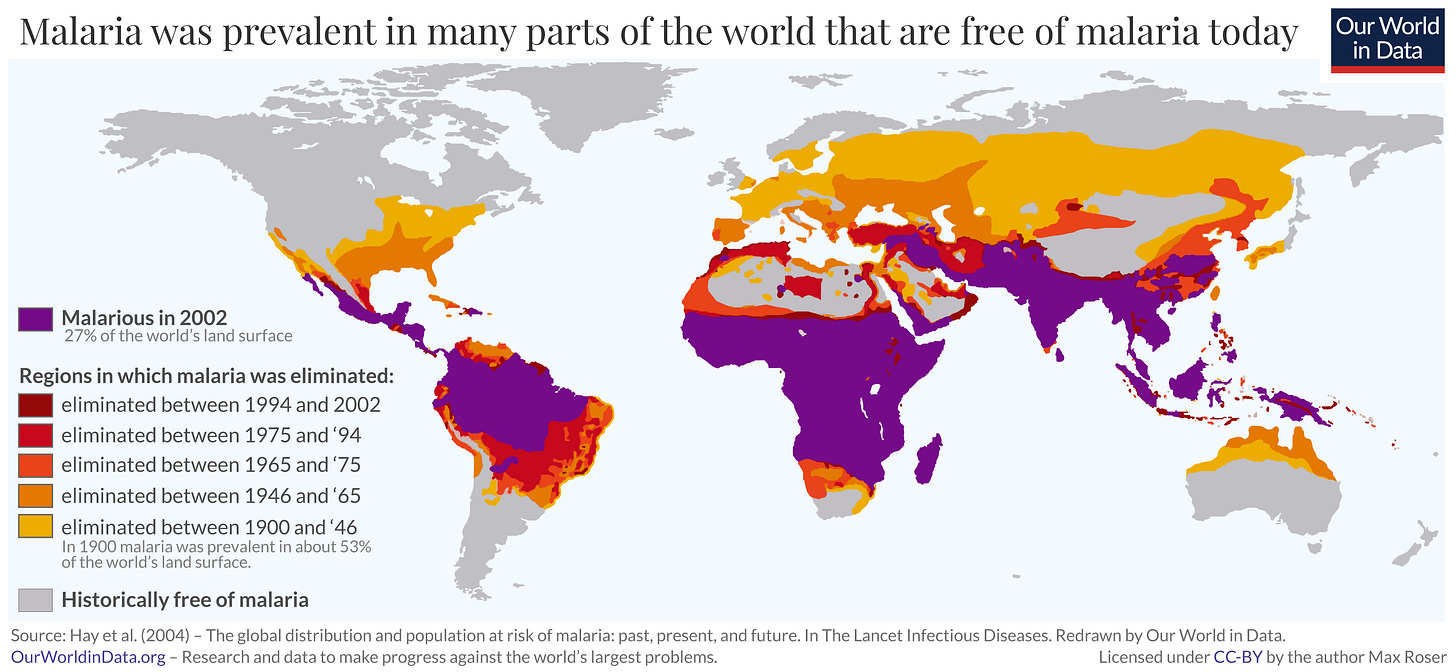
Climate Change Will Exacerbate the Mosquito Problem
Over the past century, malaria and many other MBDs have been eliminated in the developed world. However, climate change is predicted to increase mosquito populations by 30% by the end of the century. A hotter (and often wetter) planet extends breeding seasons and zones for these (literally) cold-blooded killers. Mosquitoes can boom in numbers after floods and hurricanes, which are increasingly frequent. Both globalization and urbanization also increase disease-carrying mosquito territories, expected to reach 50% of the population by 2050. Malaria has re-emerged in the US for the first time in twenty years, and new MBDs like Zika and West Nile have begun appearing.
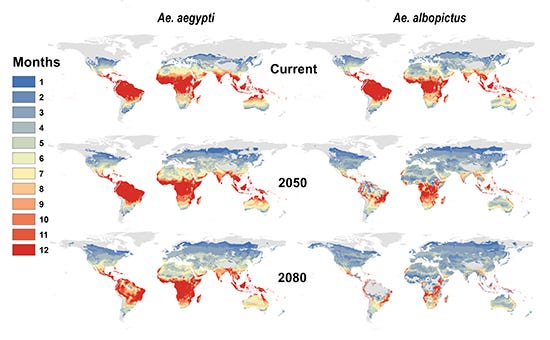
Eliminating MBDs in Both Humans and Non-Human Animals is a Moral Imperative
There are many tools—both old and new—for reducing MBD, which I describe in the next section. They should be pursued more aggressively, and we should consider techniques for elimination of MBDs in wild animals as well. By reducing MBDs in wild animal populations, we reduce many opportunities for MBDs to develop zoonotically then jumping to humans, as was the case with malaria, dengue, zika, and yellow fever (which all developed first in apes).
There are over 200 strains of malaria, but only 5 of which currently infect humans—meaning more than 90% of malaria strains are targeting animals. Malaria is a rapidly mutating disease, so vaccinating against or eliminating those 5 strains may not be a lasting solution if new strains make the zoonotic leap to humans. And that is not to mention the terrible suffering of millions of wild animals and livestock from MBDs.
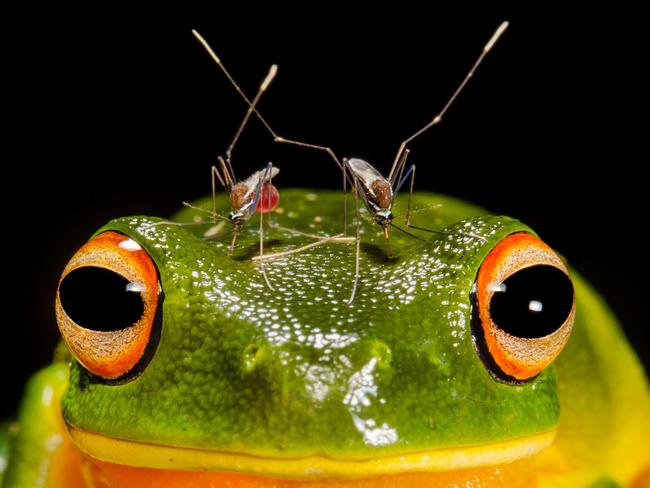
Our Tools Against Mosquito-Borne Disease
Interventions can be personal or environmental. They may entail changes to either human or ecological spaces, or eradication/modification of mosquitoes themselves. Our tools could be categorized this way:
Contact Prevention
Our frontline of defense against MBD is to prevent humans from being bitten. Mosquito bed nets and window screens are effective against transmission, as mosquitoes are most active after dusk when people are often protected, but do not eradicate disease. The Against Malaria Foundation provides mosquito nets and is an excellent charity to support in this area. Additionally, chemical-olfactory bug repellants like DEET, picaradin, and some plant extracts can be effective deterrents. Some ultrasonic deterrents are available but efficacy is unproven. Fans can also repel mosquitoes as they cannot as easily navigate the air flow or hunt based on scent.

Vaccination
MBD has proven difficult to eradicate through vaccination. This could be due to the sheer number of these diseases, their various strains, their mutability, and that some—like malaria—are caused by hardier protozoans within the mosquito saliva. We would need to develop and administer myriad vaccinations on a global scale faster than the diseases can mutate among humans, livestock, and wild animals (the last of which are impractical to vaccinate, but has been done before, and therefore remains a source of novel zoonotic strains).
There is a very clever broad spectrum vaccine, AGS-v, being developed that causes a human immune reaction to mosquito saliva itself and prevents most infections from taking root. Initial trial results are promising.

Transmission Prevention
It may be possible to “vaccinate” mosquitoes themselves. One experimental approach is infecting mosquito populations with Wolbachia bacteria, which boosts their resistance to viruses and makes them less likely to pass disease to humans (and potentially other animals). The World Mosquito Program NGO, with funding from the Australian Government and Gates Foundation, is applying this technique with some early success. Wolbachia is also used to prevent mosquito eggs from hatching, so its possible such an intervention would have a dual effect to reduce populations, but its unclear whether this happens in practice.
Wolbachia is not effective against malaria, but other researchers have developed a technique to genetically-modify mosquito populations to produce anti-bodies to malaria. Though normally malaria does not cause an immune response in mosquitoes, this new gene would turn on their immune systems against the protozoan. As with any application of genetic modification, this approach faces additional regulatory and public perception challenges despite its massive upside and lack of clear downside.
Chemical, Biological, and Moisture Control
This is our most used tool, but it is also our bluntest instrument with the most unwanted effects. Draining wetlands is historically common practice, as is use of broad-spectrum insecticidal chemicals (famously, DDT, but now a myriad of similar options). “Mosquito fogging” is popular now, but kills off-target pollinators and poisons birds while not being very effective. We are amidst an “insect apocalypse” with global insect populations declining at 2% a year, and must carefully consider accelerating this alarming trend by sterilizing landscapes.
A less directly toxic method is to introduce mosquito parasites or predators like certain fungi, nematodes, birds, or other insects. However, this can also introduce invasive species, kill off beneficial insects, and otherwise unbalance ecosystems.
An even better approach might be instead to improve ecosystems to introduce natural biological controls. Dragonflies, water striders, and small fish for example, are voracious mosquito hunters. I’ve noticed in my own pond that by creating better habitat for them, the number of mosquitoes has gone down considerably. As mosquitoes thrive in stagnant water and unhealthy ecosystems, I believe re-wilding spaces and restoring riparian habitats—such as by re-introducing beavers or biodiverse planting—could slow the spread of mosquitoes and leave places more prepared to handle mosquitoes after floods.

Targeted Population Control
There are several techniques for more precise mosquito eradication with fewer off-target effects. A major one is introducing toxic proteins of the larvidical microrganism Bacillus thuringiensis (Bt) in the form of “mosquito dunks” added to water, which prevents mosquito eggs from hatching. These are similar to the proteins introduced to transgenic Bt-corn, soy, and cotton, and unfortunately has the same problem of killing some off-target insects (though without as much residual ecosystem harm as chemicals).
There is precedent for safely eradicating entire parasitic insect species with no toxins or hydraulic engineering used: the flesh-eating screwworm. In the 1950s radiation-sterilized male screwworms were released in the Americas, which led to a population collapse of the parasite and stopped huge losses to livestock. Later, the UN FAO released 1.26 billion sterilized screwworms in Africa to great success.
Synthetic baits that mimic human odors can also be used to effectively trap mosquitoes. I’ve seen powerful household versions of this, but nothing yet that is large-scale. This could be a promising approach but more information is needed.
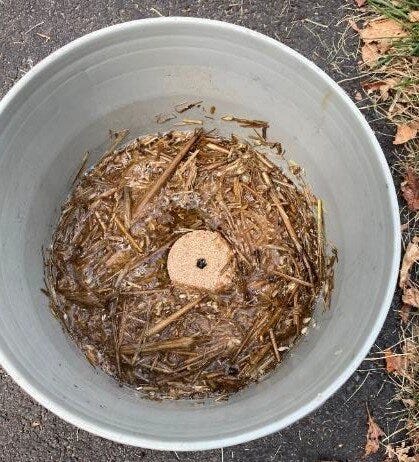
Genetic Population Control -
The most controversial mosquito control measure might also be one of the most effective. Genetic tools could be used to drive certain mosquito species to extinction or otherwise render them less harmful. It’s important to note that only a few of the over 3,000 species of mosquito carry diseases that infect humans, such as Anopheles gambiae (malaria) and Aedes aegypti (dengue, yellow fever), and thus might be eliminated this way while maintaining other mosquito populations.
Gene drive is a prime example, based on the idea of releasing sterilized males but taking it a step further. It is possible to make germline gene edits to certain mosquitoes in a lab that either sterilize them or make them less likely to pass disease. Those mosquitoes would then be released into the wild and pass those modified genes on and either kill or modify the wild population—an approach that would scale itself up rapidly. The Target Malaria NGO has received funding from the Gates Foundation to explore this approach, though it appears susceptible to political opposition as have other genetic engineering breakthroughs like Golden Rice. It could be even more fraught here as proponents seek to release GM wild animals, which theoretically have more capacity to spread than GM crops on a farm.
What Course of Action Should We Take?
The largest investment I can find in MBD elimination is a $4 billion UN budget to fight AIDS, TB, and malaria. This compares to a $6 billion UN budget for military operations, so I would argue more can be done on the MBD.
Personal protective measures like bed nets, mosquito traps, and (hopefully) vaccines have relatively little downside and cost, and should absolutely be used more aggressively. However, additional measures are necessary to eradicate MBD to avoid further entrenching global inequality and wide-scale suffering of both people and animals in (growing) mosquito areas.
Conventional eradication methods like chemical controls or draining wetlands are, however, drastically more harmful than some of the emerging methods. Mosquitoes are both pollinators (the male being exclusively nectar-eaters) and an important food source for many insects, birds, and fish. Both wildlife conservation advocates and humanitarians alike should agree that we must solve mosquito-borne disease for the benefit of both humans and animals, and to do so without directly and intentionally destroying ecosystems requires the use of advanced biological and genetic controls.
In addition to support for regenerative wetland ecosystems and personal protection, we must remain open to the use of new technology. Solutions like introduction of Wolbachia bacteria or Bt-toxin bacteria are exciting and worth further research because they will not face opposition from non-GMO lobbyists, but they will also harm off-target species and potentially degrade ecosystems. Genetic solutions like gene drive pose the greatest upside with the fewest negative effects.
If we are to defeat this antagonist of the Anthropocene we must use our most powerful tools with both humility and a sense of what is at stake.
This is Fifth Industrial, a blog scouting emerging environmental biotechnologies and strategies for a regenerative economy and lifestyle. See the posts on the most impactful bioproducts, plant cell culture, cellular agriculture, mycelium materials, synthetic silk, microbiomics, deep space food, alt cheese, alt protein CPG, biophilia, agricultural innovation engines, longevity, and egg sexing.




Nate - this piece on mosquitoes is fantastic.
If you go here:
https://www.losingmyreligions.net/
Click on "Start Reading Now" (pdf)
you should search on "mosquito"
I think you'll find some parallels. :-)